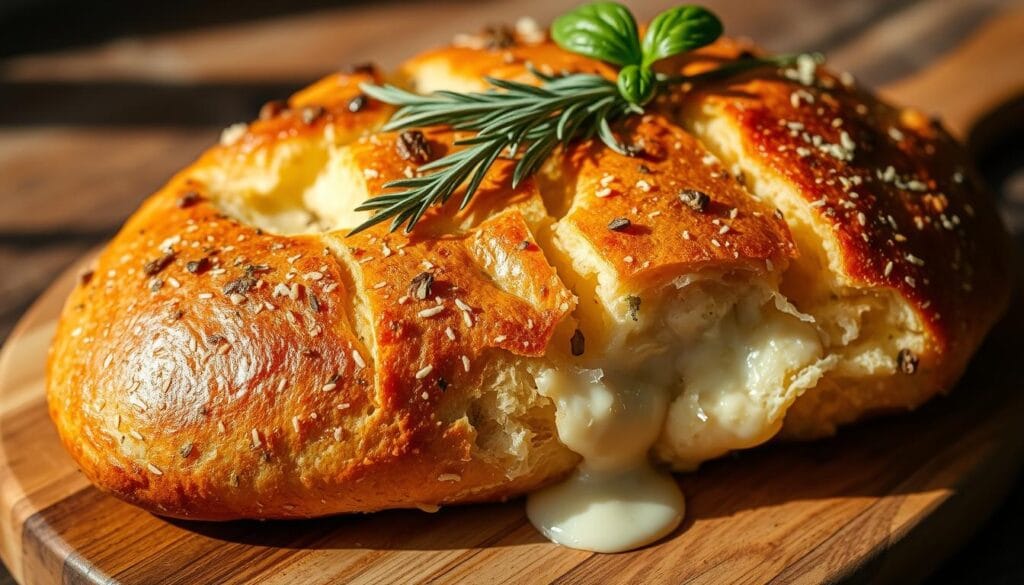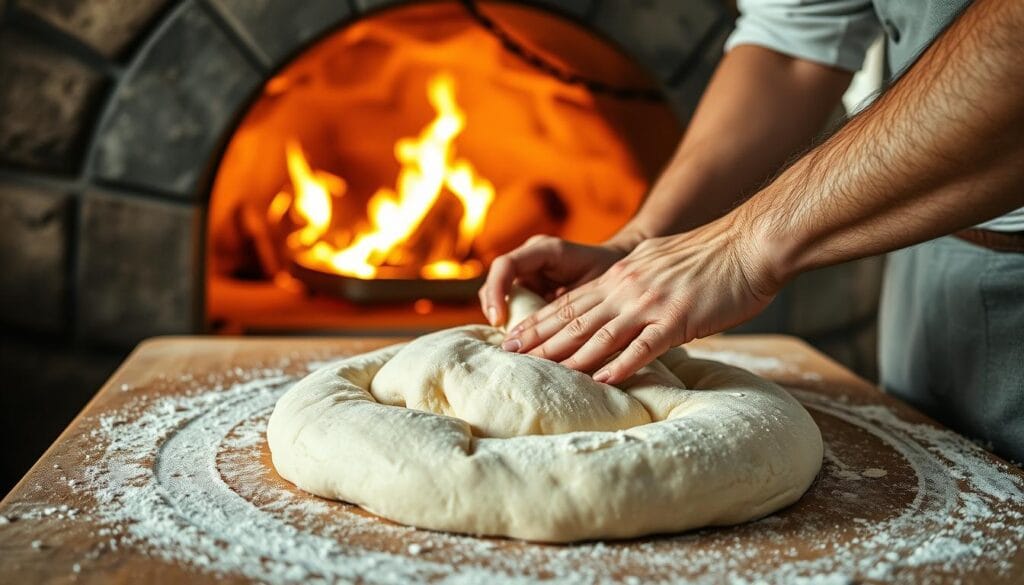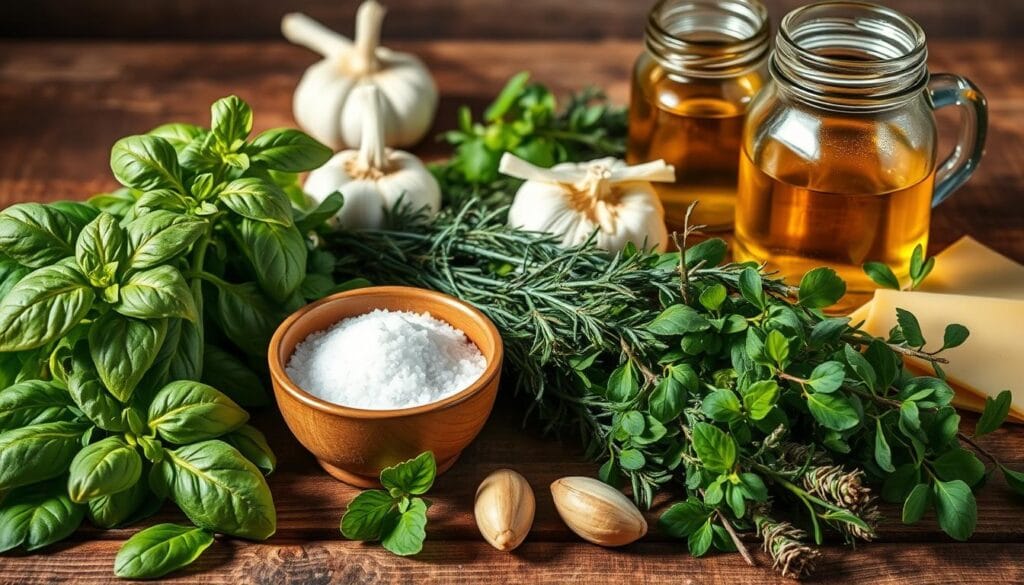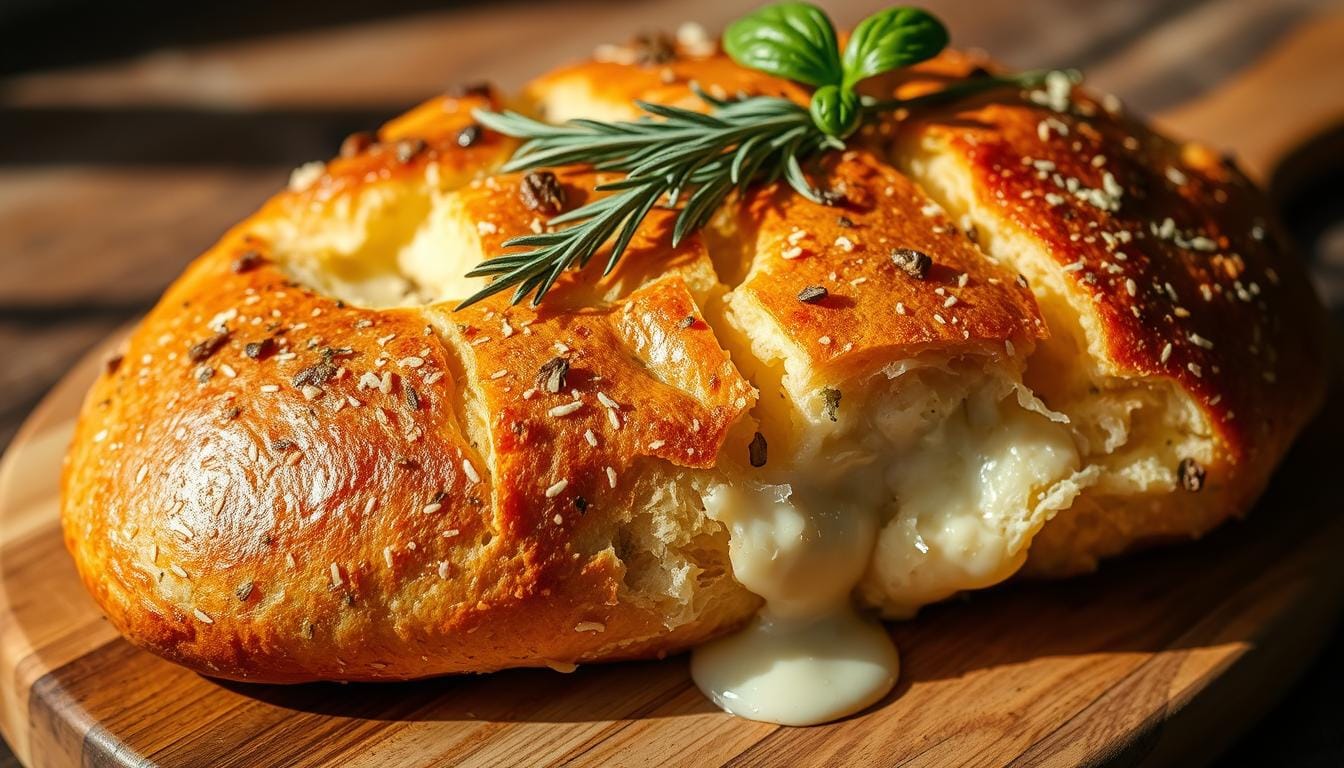Homemade Rustic Italian Herbs and Cheese Bread

Imagine the warm, inviting smell of freshly baked italian herbs and cheese bread filling your kitchen. This classic recipe turns simple ingredients into a masterpiece that delights food lovers everywhere. Making your own garlic bread lets you try traditional Italian baking and add your own twist.
Baking bread at home connects you to centuries-old traditions. The mix of aromatic herbs and melted cheese offers a unique experience. Whether you’re experienced or new to baking, this recipe will inspire you to make something special.
Key Takeaways
- Learn authentic Italian bread-making techniques
- Discover how to blend herbs and cheese perfectly
- Create restaurant-quality bread in your own kitchen
- Understand the cultural significance of homemade bread
- Explore versatile serving and pairing options
The Art of Italian Herbs and Cheese Bread Making
Making Italian bread is a journey of tradition, skill, and passion. Recipes like herb breadsticks and pesto bread share stories of Italian bakers. These stories come from generations of bakers who honed their craft over decades.

Learning to make bread is about mastering techniques that turn simple ingredients into amazing dishes. Your journey starts with knowledge and precision.
Traditional Italian Bread Making Techniques
Italian bread making is a cultural tradition. It includes techniques passed down through generations:
- Slow fermentation for deep flavors
- Hand-kneading for gluten structure
- Using natural, high-quality ingredients
- Respecting resting periods for dough development
Essential Equipment for Perfect Results
For perfect herb breadsticks and pesto bread, you need:
- Heavy-duty stand mixer
- Dough scraper
- Baking stone
- Proofing basket
- Digital kitchen scale
Understanding Dough Hydration
Dough hydration is key in bread making. The water-to-flour ratio affects texture, crumb structure, and bread quality. More water means a lighter, more open crumb. Less water makes the bread denser.
By learning these basics, you can turn your kitchen into an Italian bakery. You’ll make delicious herb breadsticks and pesto bread that truly capture the spirit of Italian baking.
Essential Ingredients for Authentic Italian Herb Bread

Making authentic Italian bread begins with the right ingredients. Each part, from flour to herbs, is key to its rich flavors. These elements make traditional Italian bread so special.
Choosing the right flour is the first step. Bread flour makes focaccia bread sturdy, while all-purpose flour is better for bruschetta. The flour you pick affects the bread’s texture and how it rises.
- Flour types: Bread flour, all-purpose flour, tipo 00 Italian flour
- Yeast selection: Active dry yeast or instant yeast
- Essential herbs: Rosemary, thyme, oregano, basil
Olive oil is a must in Italian bread recipes. It adds flavor and makes the bread tender and golden. For focaccia, olive oil is especially important, giving it a unique taste.
Fresh herbs make your bread stand out. Rosemary adds a pine scent, and oregano brings warmth. Basil on bruschetta changes the flavor completely. Try different herbs to find your favorite mix.
The secret to exceptional Italian bread lies in the quality of ingredients and the passion you bring to baking.
Each ingredient has its own story in Italian cooking. By picking and mixing these key parts, you make bread that’s not just tasty but also connects you to Italian baking traditions.
Mastering the Perfect Cheese Blend for Your Bread
Creating the perfect cheese blend can turn simple bread into a gourmet delight. Whether you’re making ciabatta bread or pizza bianca, the right cheese makes all the difference. It takes your baking from good to amazing.
Choosing cheese is an art that needs understanding of flavors and how they melt. The texture and taste of your bread depend on picking the right cheese mix.
Best Cheese Combinations for Artisan Breads
- Parmesan and Pecorino Romano: Sharp, aged cheese blend
- Mozzarella and Provolone: Creamy, mild melting combination
- Asiago and Fontina: Rich, nutty flavor profile
Proper Cheese Integration Techniques
To integrate cheese well, prepare it carefully. Grate your cheeses finely so they spread evenly in the dough. When mixing, fold the cheese gently to avoid overworking.
“The secret to perfect cheese bread lies in balancing flavor and texture.” – Italian Baking Masters
Temperature Considerations for Optimal Results
The temperature of your cheese affects the bread’s quality. Cheese at room temperature blends better into the dough. Don’t add cold cheese straight from the fridge, as it can mess with the dough’s gluten and moisture.
Try out different cheese mixes to find your favorite bread recipe. The perfect blend will make your homemade bread unforgettable.
Fresh Herbs That Define Italian Bread Making
Italian bread making is an art form that focuses on herbs and flavors. To make authentic rosemary bread and tomato bread, you need to know about fresh herbs. These herbs turn simple dough into amazing dishes.
Choosing the right herbs can make your bread special. Italian cooking loves a few herbs that add depth and character to bread:
- Rosemary: A strong herb for rosemary bread, with a pine-like smell and earthy taste
- Basil: Gives a sweet, peppery flavor that’s perfect for tomato bread
- Oregano: Adds a slightly bitter, warm taste typical of Mediterranean cooking
- Thyme: Brings subtle minty and lemony flavors
When using herbs for your bread, freshness is key. Pick vibrant, aromatic herbs with bright green leaves. Chop them finely to spread flavor evenly in the dough. For the best taste, add herbs at the start, so their oils mix well with other ingredients.
Try mixing herbs to create unique rosemary bread and tomato bread flavors. Feel free to experiment – your taste buds will lead you to tasty finds!
Step-by-Step Mixing and Kneading Process
Making the perfect italian herbs and cheese bread is all about mixing and kneading. This stage is key to the bread’s texture, taste, and quality. Learning the right techniques will boost your baking skills and make delicious loaves every time.
Proper Kneading Techniques
Kneading makes the dough strong and elastic. For italian herbs and cheese bread, follow these steps:
- Start with room temperature ingredients
- Use the heel of your hand to push and fold the dough
- Rotate the dough quarter turns consistently
- Knead for 8-10 minutes until smooth and elastic
Visual Cues for Perfect Dough
Knowing when the dough is just right is crucial. Look for these signs:
| Dough Characteristic | Ideal Appearance |
|---|---|
| Texture | Smooth and slightly tacky |
| Elasticity | Stretches without tearing |
| Window Pane Test | Thin, translucent membrane when stretched |
Troubleshooting Common Dough Issues
Even skilled bakers face challenges with italian herbs and cheese bread. Here are fixes for common problems:
- Sticky Dough: Add flour gradually, one tablespoon at a time
- Dry Dough: Incorporate water in small increments
- Tough Texture: Avoid over-kneading and use gentle folding techniques
Pro tip: Practice makes perfect. Don’t get discouraged if your first few attempts aren’t ideal.
Proofing and Shaping Your Rustic Loaf
Making the perfect rustic bread is all about proofing and shaping. These steps are key, whether you’re baking traditional Italian bread or making herb breadsticks. They’ll take your baking to the next level.
Proofing turns your dough into a light, airy delight. It’s when yeast works its magic, creating air pockets. This is especially important for pesto bread and other herb-infused loaves.
- Let dough rise in a warm, draft-free environment
- Cover with a damp cloth to prevent surface drying
- Ideal proofing temperature ranges between 75-80°F
Shaping your bread needs gentle care to keep those air bubbles. Techniques vary between different bread styles. Herb breadsticks, for example, need a special touch.
“Bread shaping is an art that transforms simple ingredients into culinary magic” – Italian Baking Masters
When shaping, use tucking and rolling to create surface tension. This helps get a crisp outside and a soft inside. With practice, you’ll get better at making perfect herb breadsticks and rustic loaves.
Baking Tips for the Perfect Golden Crust
Making a perfect golden crust is an art in bread baking. It’s especially true for Italian-style breads like focaccia and bruschetta. The right baking methods can turn your homemade bread into something amazing.
Professional bakers know that a stunning crust is all about precision. The look of your bread’s outside can make or break it.
Temperature and Timing Guidelines
Mastering temperature control is key to successful bread baking. Here are some important tips for perfect results:
- Preheat your oven to 450°F (232°C) for most Italian bread varieties
- Use an oven thermometer to verify accurate temperature
- Allow 35-45 minutes of total baking time
Steam Techniques for Crusty Results
Steam is crucial for a crispy, golden crust. Bakers use different methods to add moisture during baking:
- Place a metal pan with water on the bottom oven rack
- Spray water into the oven during the first 10 minutes of baking
- Use a Dutch oven with a lid for trapped steam
Signs of Perfect Doneness
Knowing when your bread is perfectly baked takes attention. Look for these signs:
| Visual Cue | Internal Temperature |
|---|---|
| Deep golden-brown color | 200-210°F (93-99°C) |
| Crisp, hollow sound when tapped | Indicates proper internal cooking |
| Firm, slightly resistant crust | Shows complete baking process |
“The perfect crust is a delicate balance of heat, moisture, and timing.” – Artisan Baker’s Wisdom
Whether you’re making rustic focaccia or crisp bruschetta, these tips will help you become a pro at bread baking.
Serving Suggestions and Pairing Ideas
Make your homemade Italian herbs and cheese bread stand out with creative serving ideas. Whether it’s ciabatta bread or pizza bianca, the right pairings can make it a highlight of your meal.
Perfect Bread Pairings
- Create a rustic antipasto platter with cured meats and cheeses
- Prepare bruschetta with fresh tomatoes and basil
- Serve alongside hearty soups and stews
- Craft gourmet sandwiches using your homemade bread
Try different dips to boost your bread’s flavor. Here are some classic Italian options:
| Dipping Option | Flavor Profile |
|---|---|
| Extra Virgin Olive Oil | Rich, smooth, authentic Italian taste |
| Balsamic Reduction | Sweet and tangy complement |
| Herbed Butter | Creamy, aromatic enhancement |
To keep your ciabatta bread or pizza bianca fresh, wrap it in a clean towel. For best taste, eat it within 2-3 days. Store it at room temperature in a bread box or paper bag.
Pro tip: Revive day-old bread by lightly toasting or warming in the oven for a fresh-baked texture.
Conclusion
Making homemade bread is like connecting with Italian traditions. Your skills in making rosemary and tomato bread are more than just cooking. They open up a world of flavors and old techniques.
As you keep making bread, remember each loaf has its own story. The skills you’ve learned can turn simple ingredients into amazing dishes. Your passion and creativity will show in every loaf, whether it’s rosemary or tomato bread.
- Practice different herb combinations
- Experiment with various cheese blends
- Share your creations with friends and family
- Document your bread-making progress
The bread-making journey never ends. Each loaf you make brings you closer to mastering Italian bread crafting. Don’t worry about mistakes—they help you get better.
“Bread is the king of the table and all else is merely an accompaniment.” – Unknown
Keep exploring, stay curious, and enjoy the tasty results of your creativity.
FAQs About Italian Herbs and Cheese Bread
Wondering how to store your homemade Italian herbs and cheese bread? Keep it fresh at room temperature for 2-3 days. Wrap it in a clean kitchen towel or store it in a bread box. For longer storage, slice the bread and freeze it in an airtight container for up to a month.
Reheating your garlic bread needs gentle care. Warm it in a preheated oven at 350°F for 5-7 minutes. This keeps the crispy exterior and soft interior. Avoid microwaving, as it can make the bread soggy and tough.
Many home bakers wonder about making dough ahead of time. You can prepare the dough and refrigerate it overnight for slow fermentation. This process enhances the flavor of your herbs and cheese bread. Just let the dough come to room temperature 1-2 hours before baking.
Dietary restrictions shouldn’t stop you from baking. For gluten-free options, use a high-quality gluten-free flour blend. Vegan bakers can use nutritional yeast or plant-based cheese alternatives. Try different herb combinations to find your favorite Italian bread recipe.
FAQ
How long can I store homemade Italian herbs and cheese bread?
Store your homemade bread in an airtight container at room temperature for 2-3 days. For longer storage, wrap it tightly and freeze for up to 1 month. When you’re ready, thaw at room temperature and briefly warm in the oven to restore its crispy crust.
Can I make this bread without dairy if I’m lactose intolerant?
Absolutely! Use dairy-free alternatives like nutritional yeast or vegan cheese for flavor. Replace dairy milk with plant-based milk or water. Choose a dairy-free olive oil to keep the bread’s rich taste.
What are the best herbs to use in Italian bread?
Classic herbs include rosemary, thyme, oregano, and basil. Rosemary gives a robust flavor, while basil adds a fresh, sweet taste. Use fresh herbs for a more vibrant taste. You can also create your own unique blend.
How do I know when my bread is fully baked?
Look for a golden-brown crust and check the internal temperature with a digital thermometer. It should be 190-200°F. The bread should also sound hollow when tapped and feel light with a crisp exterior.
Can I prepare the dough in advance?
Yes! Prepare the dough and refrigerate it overnight for a slow fermentation. This enhances the bread’s flavor and texture. Store it in the refrigerator for up to 24 hours before baking.
What type of flour works best for Italian herbs and cheese bread?
Bread flour is best due to its high protein content. It creates a chewy texture. For a lighter bread, use all-purpose flour. Mixing in semolina or 00 Italian flour adds an authentic touch.
How can I prevent my cheese from burning during baking?
Add cheese later in baking to prevent burning. Sprinkle it on top during the last 10-15 minutes. Or, mix grated cheese into the dough. Brushing with olive oil helps the cheese brown evenly.
Is it possible to make this bread gluten-free?
Yes, use a gluten-free flour blend for a gluten-free version. Add xanthan gum to mimic gluten’s binding properties. Adjust liquid amounts and expect a different texture than traditional bread.
What’s the best way to reheat leftover Italian herbs and cheese bread?
Reheat in an oven preheated to 350°F for 5-10 minutes. This restores the crispy crust and soft interior. Avoid microwaving, which can make the bread tough. Wrap in foil if it’s dry to retain moisture.
Can I add additional ingredients to customize my herb and cheese bread?
Definitely! Add sundried tomatoes, olives, garlic, roasted red peppers, or pine nuts for unique flavors. Be mindful of moisture content and adjust liquid amounts to keep the dough right.

